The weather was a little indifferent at the start of December and the water temps were slow to come up. This had the mako shark fishers scratching their heads. The temps came on in the later half towards Christmas and they look set to continue to rise well into January.
Some anglers were suggesting makos were getting thick, as being harassed while bottom dropping was quite regular, and in very early December we saw an increased number of blue sharks seen in berley trails. These guys are ok to have the kids practice on but hardly put up a fight, and I am yet to find a way to make them taste any good.
What was of interest on one particular session was the pilot fish swimming alongside the sharks. These little fish are of the same ilk as a remora, apart from they don’t suck on they just swim beside their host, and they feed on the ectoparasites and the leftovers around the shark. They are banded black and white and can grow as large as 60cm in length. They are normally found cruising with Oceanic white tip sharks and favour the warmer water. It was a quite strange sight given the early appearance and water temps.
Mako sharks are starting to fire up. These are without doubt Tasmania’s adrenalin fish. They have the ability to pull hard and go on scorching runs, bog down deep and then scream for the surface and on into the air, which is why we don’t fight them from a static boat and trundle off as they take the bait. Do not get sucked into thinking you need to find a lot of depth.
If you come across some schools of bait on the sounder or on the surface visually, pull up and make a start. When they are in good numbers a 4hr stint should have something of interest at the back of the boat. Once we get over the 6 hour mark and not see a fish, the bottom lips start to drag. Fear not, as that is also the beauty of shark fishing – expect the unexpected! Get into your local tackle store and get some gear that will tailor to Tasmanian conditions, find out any info and stock up on a variety of baits. Mako are voracious eaters but at times they can be surprisingly finicky. Squid, mullet, striped tuna and salmon are all great baits to have on board.
Trumpeter, these fish are probably Tasmania’s version of the snapper craze they have in Vic and SA. They are an abundant species and with the right rigs and bait are quite easy to catch. Locating them is the tricky bit. Having someone else’s marks has been the easy way to get some in the boat in the past. Those anglers that have invested some time into understanding and getting to know how to get the best out of their sounders are doing well. Fresh ground is often fruitful leading to great catch rates and often some bigger fish.
Three hook paternoster rigs have been the norm for many years, with good fresh bait and an outfit that brings in a good amount of line with one turn of the handle. These fish are often found in water between 50-400m deep so a good stiff rod to complement an Alvey style or big egg beater is the go.
The other big name to come from the deep during January is the blue eye trevalla, which is famed for its eating quality. The use of electric reels has really stepped up over the last couple of years. The long lining by recreational fishers has slowed and the take up of electric reels and rods to suit the fishing has been awesome.
I love the super deep fishing with electric as you never know just exactly what goggle eyed monster is going to come up and say hello – rays, bream, hapuka and gem fish are all welcome species to be introduced to the ice box.
Remember to keep the fish you have caught in good nick. Doesn’t make any sense to go to the significant trouble of organising a day out on the shelf and leave fish lying around the boat with their guts in. Bleed ‘em, get them into an ice slurry, find some time to field dress them and get the fillets on ice.
There is always a chance of an early striped tuna and albacore tuna run, if the currents are favourable. We like to troll some skirts and sub surface lures for 15 minutes before we arrive at the shelf for a bottom fish early in the season.
We will do the same as we leave the bottom fishing grounds, weather and time permitting. This allows you the chance of picking up some striped or albacore tuna. The stripes make excellent berley for mako, and the albacore are sensational eating if not cooked too much to dry out.
If we all cross our fingers together we should see some hot, cloudless blue sky days in January. If you are a fly fisher of any kind these are happy days as it will allow even a novice to try their hand at polaroiding. The clear bright conditions will allow you to use your polarised eyewear to great effect.
Sight fishing is best when the sun is high allowing great penetration into the water surface. Traditionally this is between 10am and 4pm. If you are just starting out, find some areas that have clear water and not too much for the fish to hide themselves under (you won’t be the first person to make repeated presentation to a fish-shaped rock either!).
Having limited knowledge of the best places to have a crack I asked a guru and the word came back to try the bays of Lake Echo, the western side of Great Lake, and shores of the Brady's chain of lakes. Lake St Clair is also an awesome area to try your luck. The Western Lakes are equally exceptional in their fishing and degree of difficulty. The catch rate is on average a bit lower but the satisfaction of sighting and tricking a wild western trout makes it worth the effort. To avoid frustration and busting your treasured fly rod over your knee a couple of times you may wish to delay a visit until you have already notched up a few trout from easier waters.
There will still be plenty of action from the array of hatches right into mid to late January. The last few weeks will see the mayflies start to dissipate until their return in mid to late February. Good news for fly fishers is the start of the hopper fun. Grasshoppers are not just confined to the fly fishing fraternity and everyone can enjoy this time of year when the grasshopper becomes the number one food of choice!
I was again lucky enough to be away with Adrian ‘Mozza’ Morrisby and we managed to get out on Port Phillip Bay for the very first time. Snapper, of course, were on the target species list as Mozz had never caught one and I have only ever caught little ones off the Mornington Pier. I did however spear a good-sized one once but Mozz was quick to point out that didn’t count. But we did manage to get the job done.
This trip highlighted once again, just how much we are missing out on in Tasmania by not having the ability to easily fish at anchor. Now I say easily as it’s simple to drop anchor, but it is the pulling up that is the crux of our issue here in Tasmania. There are not a whole heap of vessels that have power winch or windlass (the term windlass is an engineering term for a horizontal drum used to raise and lower something via a rope stored on the drum).
What invariably happens in Tasmania without a power windlass is it all becomes a bit of a task. The keenest of anglers will get sick of the sight of the anchor rope after dropping and moving 5 times. It’s just a pain and traditionally we don’t do it, but we are actually doing ourselves an injustice on a number of levels. The boat is being underutilised and without the ability to raise the anchor at will, with very little fuss, we loose some of the inherent useability of a craft with a powered anchor.
I hate it when people default to a safety aspect and wave the OH&S flag, but in this instance there is merit in this discussion. In most cases when an anchor has to be deployed in an emergency it needs to be done swiftly and without fuss. Often a swift deployment of anchor stops a bad situation snowballing into something much worse.
We had a trip last year on a mate’s rig and we were down the wild west and it was getting dark. We found a cray boat mooring just south of Macquarie Heads. We were tying up to this fore and aft in a 6m boat when it was deemed my role to be out on the bow. I looked into the anchor well and what I saw was a mess. You could not have had a bigger tangle if you set out to deliberately do it. I doubt the anchor had been put down in years and in rough seas the rope chain and rope had been playing a good game of leapfrog. It took ages to sort out and get right. I make this point because if we had ever needed to deploy that anchor in haste on that trip or any prior trip it just would have failed.
The powered windlass or winch is not only easy to deploy and retrieve the very nature of its design means that it is neat and tidy. The rope and chain are wrapped securely on the drum and anchor secured firmly in the bow sprit. Always ready for action at the press of a button.
Using anchor at will at the drop of a hat makes a boat a much more pleasurable item of ownership. I find that much like carrying a Swiss army knife; the world becomes an easier place to live. If you have to stop and do anything on the boat, being able to find a spot and drop anchor makes it all a lot easier. Once the pick is down and you lay back on it you will be more than likely out of the wind. Most boats have varying degrees of cover and having lunch, rigging tackle and sorting gear is always a lot easier when on the anchor. Once done a simple powered retrieval and you are on your way again. There is an awesome social aspect to anchoring up as a group and enjoying lunch or a swim off the back of the boat.
We like to back ourselves and find the fish, but we can also use technology and have the fish find us. Using your sounder and powered windlass in conjunction is a very effective way to fish. Scour the sounder and find the bottom you are after for the given target species.
Once you have found good bottom and the sounder screen’s showing good fish arches, lay a waypoint down. The trick here is to then work out with the wind and current a drop point that will have you laying back on the anchor close to the waypoint you have marked. This will only come with practise with trial and error, but worth it.
Now this is a section for the technical-minded but will have information that all boaters should store away. The line and chain on the drum is called the ‘rode’ and the amount of anchor rode you should have out for a good set is called the ‘scope’. The scope depends on the amount of water you wish to hold bottom in and there is a simple formula: water depth x 5 is a good general rule of thumb to have you hold good bottom. Now you can see why those fisho’s that like to anchor gravitate to the good quality dyneema cord available. This is strong while of lesser diameter allowing for more to be stored on the drum.
Once you have a good set and you are happy with your efforts, place a waypoint exactly where you are as a reference and check every now and then. You will soon see if you are dragging anchor.
Once you have set the anchor, it is time for you to throw some handfuls of berley. This will depend on what inshore species you are trying to target. Be it small pieces and pellets for whiting or larger cubes for gummies and snapper, it doesn’t matter get some out early then a constant dribble from then on. You can often find while you are setting up and getting organised the berley has done its work and the fish have started to come to you as the baits go down.
Importantly, and not often spoke about, is the number of rods you can fish on the pick. Due to holding ground and not moving you can fish more rods than if adrift, especially if there is little or no current. For this reason fishing at anchor is the best way to take kids fishing and have them enjoy their day catching and not waiting for Dad to sort a tangle. The other bonus when at anchor fishing is the reduced likelihood to get snagged up.
If you like catching and eating squid, then now is the time! Southern calamari are a year round proposition for Tasmanians but summer is when people hit the water and jetties to do their best work. Daylight savings and warm summers nights are great times to be out chasing squid until dark or a bit after. It is this time of year that the squid are at our shores in droves – it’s an invasion!
Fish the broken ground, and by that I mean rocky and sandy together, and if you can find some weed beds even better. If the broken ground also happens to be harbouring parrotfish you are on the money. They seem to like to hang out together on similar habitat. Start in as shallow as 4m and work your way out to find them. If you can see the bottom at 6m all well ,and good as clear water in good nick is a great start.
Whether to drift or fish at anchor? Both techniques work well, however I like to use drifting to find them and then use the anchor to load up on them. They are often in packs and when you come across one there will be a few.
If you prefer to drift take note of each drift line on the sounder and when you pick one up put down a waypoint. After a number of drifts you may see a pattern forming that will give you a better idea on your next drift line or decide to anchor.
In bright conditions, as with any species, try and match the hatch. Any jig looking to replicate what the baitfish will be is a great start. Mullet and pike coloured patterns are a superb choice. When the conditions get a bit overcast start to break out the brighter colours. Always have a lumo jig or two on the boat and a head torch for those dusk and dark conditions.
You can pay what ever you want for a squid jig, but a good jig will give you a long life of service without breaking up or getting rusty. There is nothing worse than a 3kg squid spilling its guts out of a cheap jig.
Make sure you have a good well made rubber landing net for two main reasons: firstly, too many good squid are lost boatside, and secondly, a net will allow you to hold them out over the side while they have a squirt fest.
A net with a rubber inner is easily washed and less likely to have lures and jigs tangle, which means more time fishing. Don’t forget that squid move by squirting water forward, so get the net in behind them.
Get online and have a look at a few Youtube vids of how to clean squid quick and easy. Find one you like and practise.
Don’t waste your squid, what you don’t eat can be fished or bagged and freeze as bait.
The GFCNT is setting itself up for a sensational year building on hard work from the committees of past and present. It has the strongest membership base in Tasmania and is always looking to provide value to its membership. The club held an information night recently and the members appreciated it greatly.
A new initiative for the club was an information night not just for members, but involving anyone with an inkling of interest in all forms of game fishing. The club was impressed with the interest with over 120 people enjoying a great evening at the Mersey Yacht Club. The night had some tremendous feedback from those in attendance and the format was praised. A short introduction followed by the crowd grouping at 6 information stations and moving clockwise after a time frame worked well. There was also time allocated for questions and anyone wanting to dig deeper into the basic topics that were on offer.
The club holds the biggest and long regarded as the best shark fishing competition in Tasmania. This event has seen 60 vessels all leaving the Mersey River hoping to catch the big one or tag the most mako. The competition has always had a very healthy tag and release aspect in which it prides itself. This is an event that draws an excellent crowd and some of the on shore activities are designed to entertain the kids that come along.
The success of the shark competition and other initiatives have driven the GFCNT to the head of the pack within game fishing circle in Tasmania. Their inaugural Triabunna event was a massive success and proved very popular with anglers from around the state. This event was about community involvement and helping a regional coastal town get on its feet after some industry sectors falling away. The GFCNT invited the president of the cruising yacht club to speak at the event safety briefing and he mentioned how awesome it was to have game fishers and their families in town.
“This is the most people I have seen in the pub in 40 years!” he said
The event showed those that attended that Triabunna indeed has a heart beat and has plenty to offer the game fisher men and women.
The club goes from strength to strength and anyone interested in joining or more information can find them on their facebook page. https://www.facebook.com/GameFishingClubOfNorthernTasmania?fref=ts.
Devonport Shark Comp will be held on Saturday January 10, and this year’s event is proudly sponsored by Civilscape Contracting and Heather and Bob Duncombe.
Reads: 5150
Two small blue shark with a pilot fish in tow.

Bradley Day with a nice hapuka caught in December.
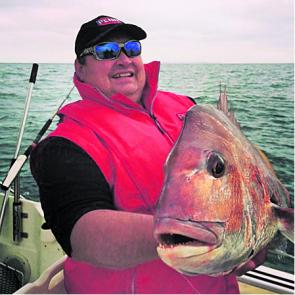
Mozza with a good snapper from Port Phillip Bay
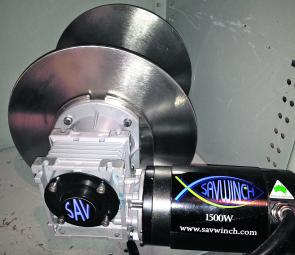
A Sav winch will make fishing at anchor a whole lot easier.
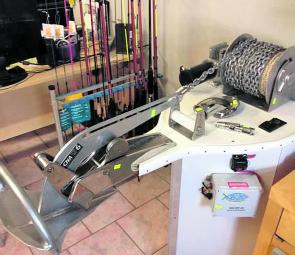
Full kits are available to retro fit to any size vessel (7)
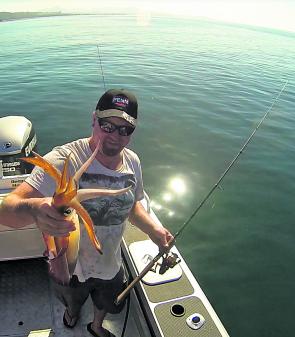
It’s a squid invasion this season!

Ashleigh Cooper onto a Tassie monster.
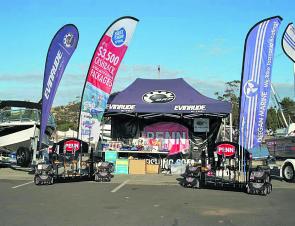
Triabunna prize pool was a cracker.




